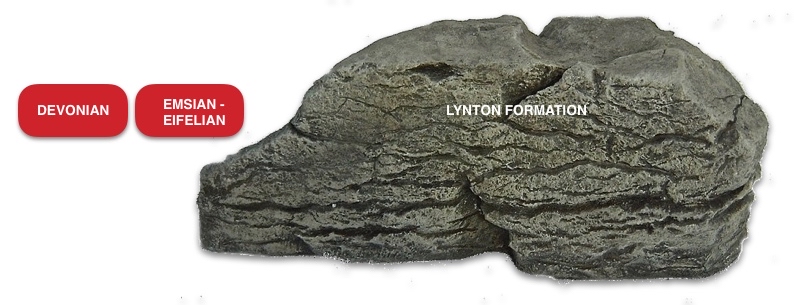The Valley of the Rocks is a popular tourist destination, especially for hikers, artists and writers. The dry valley has cut through Devonian Lynton beds, which are highly fossiliferous. The coastal road, west of Lynton, runs through this valley, with plenty of car parking space for visitors. It has been popular ever since a number of famous writers visited the area in the sixteenth century.
DIRECTIONS
♦ Head to the village of Lynton from the A39 on the B3234.
♦ The Valley of the Rocks is well signposted and should be easy to find. Drive through Linton and continue along the coastal road.
♦ There are car parks at both the western and eastern ends of the valley. The walk from the car park at the eastern end is much longer than from the other end. However, it has toilets. A cafe is situated about half way between them.
♦ This location is suitable for children.
♦ Ref: 51.23231°N, 3.85229°W
PROFILE INFO
FIND FREQUENCY: ♦♦♦♦ – The middle part of the Lynton Beds, which is exposed at this location, is highly fossiliferous. This is the best place to find fossils. Please note that this is an SSSI and collecting is only permitted from the loose scree. Hammering is not allowed on bedrock or cliffs.
CHILDREN: ♦♦♦ – This location is suitable for children and the bottom of the slopes provides plenty of opportunity to find fossils. Please note that the walk around the seaward side of the Valley of the Rocks can be dangerous for small children, due to the narrow path with a sudden drop down to the sea.
ACCESS: ♦♦♦♦♦ – The Valley of the Rocks is easy to find, being well signposted from Lynton. The western car park offers parking right next to the fossiliferous rocks, while the eastern park offers toilets. Between the two, there is a cafe. This is certainly a site accessible to all.
TYPE: – Fossils are found in the large number of scree slopes throughout the valley. Many of these run beside the main footpaths. Note that hammering is not permitted on the bedrock due to SSSI restrictions, but plenty of fossils can be found in the loose material.
FOSSIL HUNTING
When you walk through the Valley of the Rocks, you will notice a number of scree slopes and rock faces. The scree slopes contain a large number of fossils from the Lynton Beds and are the only areas you can collect fossils from. The most common finds are brachiopods, crinoids, plants and trace fossils. The bryozoan Fenestella antique is particularly common.
The best area seems to be the scree slope just west of the western car park on the north side of the road. Trace fossils, such as worm tubes, can be found here. Keep an eye out for grey gritty rocks, as these are the most fossiliferous. The brachiopods Turbinolopsis pluriradialis, Spirifera osliolata and Spirifera aperturata are also common.

GEOLOGY
The Valley of the Rocks was formed by coastal erosion of a former extension of the valley of the East Lyn River. The valley gradually receded, migrating the river to its present position, where it now enters the sea at Lynmouth. The Valley of the Rocks is the old valley from where the East Lyn River used to flow.
The middle part of the Lynton Formation is exposed in the Valley of the Rocks. These are the oldest Devonian rocks in Devon and are of Emsian – Eifelian age.
Extensive exposures of the Lynton Formation can be seen at this locality, comprising of massive quartzitic sandstones with interbedded finely laminated slates. Heavy cleavage and bioturbation obscures a lot of the lithological details. Most of the rocks here are a grey colour, with some of the most fossiliferous also being gritty. However, the red coloured rocks are not fossiliferous.
The north side of the valley are fossiliferous localities where screes developed around Castle Rock and Rugged Jack). These provide a fauna dominated by brachiopods with lesser numbers of bivalves, bryozoans and abundant crinoid ossicles. The brachiopod fauna includes Platyorthis triangularis, Chonetes sarcinulatus, Schelwienella sp., Subcuspidella lateincisa, and Subcuspidella longeincisa.


SAFETY
This is a very good site and safe for all the family. However, please be aware of rock falls, which do happen from time to time. It is safest to collect from the scree whose slopes are less than 45 degrees. Be careful if taking the seaward path, as this is narrow with a large and sudden drop below to the rocks below.
EQUIPMENT
You do not need any tools here, just a good eye and something to wrap the fossils in. Fossils are simply found loose amongst the scree.
ACCESS RIGHTS
This site is an SSSI. This means you can visit the site, but hammering the bedrock is not permitted. For full information about the reasons for the status of the site and restrictions please download the PDF from Natural England – SSSI Information – Valley of the Rocks
It is important to follow our ‘Code of Conduct’ when collecting fossils or visiting any site. Please also read our ‘Terms and Conditions‘
LINKS
♦ Buy Fossils, Crystals, Tools
♦ Location Discussions
♦ Deposits Magazine
♦ Join Fossil Hunts
♦ UK Fossils Network


























